Investors turn short on most Asian FX as dollar strength prevails- Reuters poll
By Roushni Nair
(Reuters) - Analysts turned bearish on most Asian currencies, with short bets on the Indian rupee at a one-year high, as expectations the Federal Reserve would cut rates less aggressively strengthened the dollar and took the shine off riskier Asian assets.
Short positions in the South Korean won, the Philippine peso and the Indonesian rupiah are at their highest since July 25, a fortnightly poll of 11 analysts showed on Thursday.
Bullish bets in the Chinese yuan, Singapore dollar, Malaysian ringgit, and Thailand's baht also reduced significantly from early October.
Rising demand for the dollar in the backdrop of waning expectations of outsized Fed rate cuts and uncertainties over the U.S. elections has weakened investor confidence in Asian currencies.
The dollar index , which measures the greenback against six major rivals, has risen 3% so far since Sept. 30. The index is currently trading at 103.57, a high last seen in late July. [USD/]
In India, the rupee declined past 84 per U.S. dollar last week - a level the Reserve Bank of India had defended for more than two months - as the recent spike in oil prices could increase bills for the net-importer, and as the exodus of foreign money from the domestic equity market pressured the local unit.
Responses to the poll were received before central banks in Thailand, the Philippines, and Indonesia made interest rate decisions on Wednesday.
The Bank of Thailand and Bangko Sentral ng Pilipinas (BSP) cut rates while the Bank Indonesia maintained status quo.
"Though fundamentals show that rates should be cut towards neutral now, the weakening in the peso should keep the BSP cautious with the pace of easing, careful to go faster than the Fed," said Eugenia Victorino, head of Asia strategy at Skandinaviska Enskilda Banken.
In Thailand, despite government support for the rate cut, the baht remains the second-best performing currency in Asia this year, up nearly 3% so far this year and surpassed only by the Malaysian ringgit.
Oil price volatility faltered investor confidence in the ringgit - also called a proxy to the yuan due to trade relations with China - as Malaysia stands out as the only net oil and gas exporter among the major emerging Asian economies. [O/R]
Meanwhile, short positions on the Taiwanese dollar were at their highest since Aug. 8.
Confidence in Taiwan's export-dependent, tech-heavy economy came under pressure after a report said the Biden administration was considering capping sales of advanced artificial intelligence processors to some countries.
The Asian currency positioning poll is focused on what analysts and fund managers believe are the current market positions in nine Asian emerging market currencies: the Chinese yuan, South Korean won, Singapore dollar, Indonesian rupiah, Taiwan dollar, Indian rupee, Philippine peso, Malaysian ringgit and the Thai baht.
The poll uses estimates of net long or short positions on a scale of minus 3 to plus 3. A score of plus 3 indicates the market is significantly long U.S. dollars.
The figures include positions held through non-deliverable forwards (NDFs).
The survey findings are provided below (positions in U.S. dollar versus each currency):
DATE USD/CNY USD/KRW USD/SGD USD/IDR USD/TWD USD/INR USD/MYR USD/PHP USD/THB
17-Oct-24 -0.43 0.26 -0.44 0.04 0.24 0.67 -0.40 0.26 -0.28
03-Oct-2024 -1.14 -0.79 -1.26 -1.08 -0.59 -0.04 -1.18 -0.70 -1.45
19-Sep-2024 -0.67 -0.90 -1.12 -1.18 -0.66 0.33 -1.30 -1.10 -1.33
05-Sep-24 -0.85 -1.09 -1.26 -1.05 -0.77 0.21 -1.46 -1.00 -1.22
22-Aug-24 -0.62 -0.93 -1.08 -1.26 -0.70 0.21 -1.57 -1.03 -1.16
08-Aug-24 -0.02 0.05 -0.61 -0.02 0.59 0.60 -0.78 -0.29 -0.57
25-Jul-24 1.07 0.79 -0.33 0.35 0.86 0.12 0.39 0.43 0.02
11-Jul-24 1.05 0.87 0.06 0.73 0.68 0.22 1.03 0.86 0.51
27-Jun-24 1.34 1.28 0.80 1.49 0.88 0.46 1.00 1.37 0.91
13-Jun-24 0.95 0.87 0.62 1.22 0.64 0.37 1.00 1.23 0.92
Source: Investing.com
